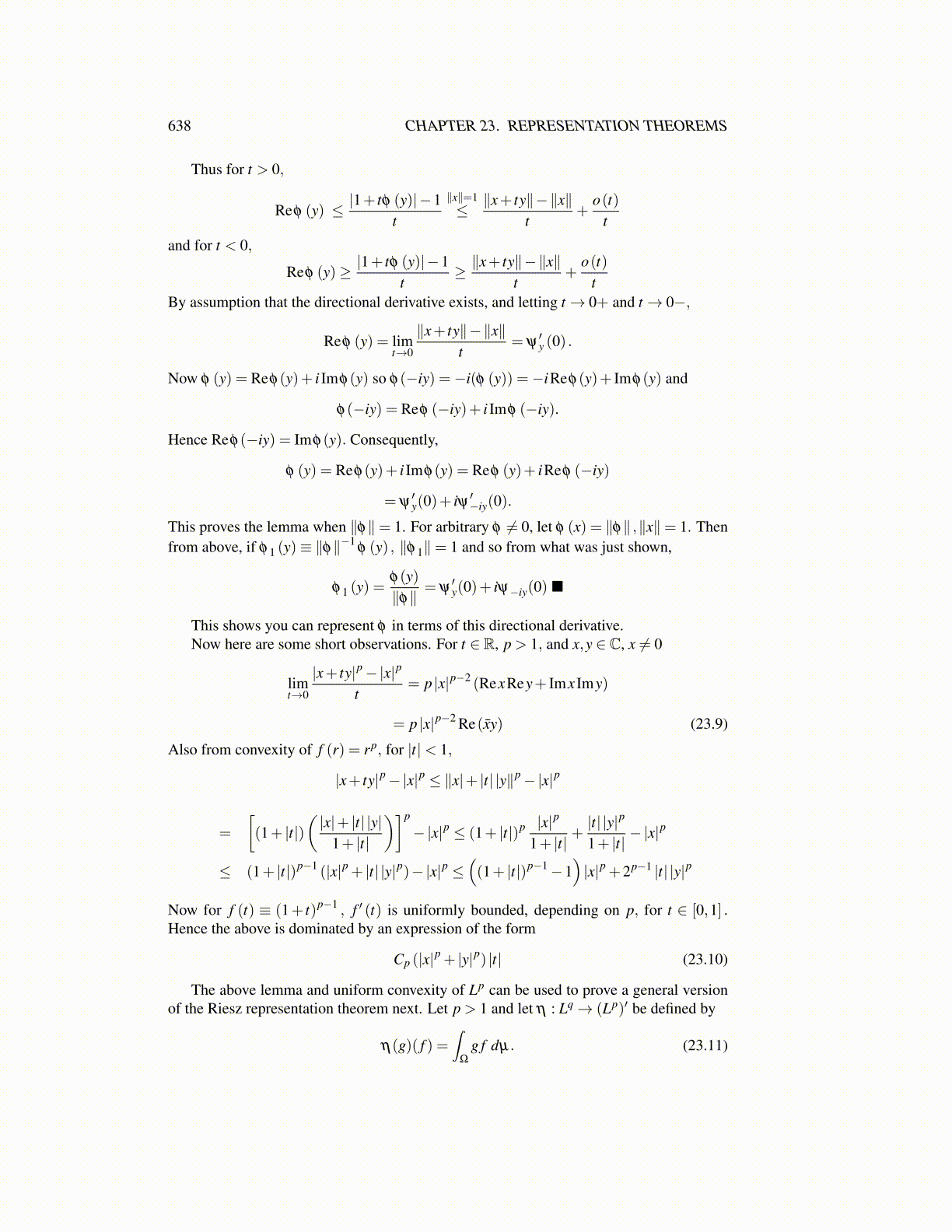
638 CHAPTER 23. REPRESENTATION THEOREMS
Thus for t > 0,
Reφ (y) ≤ |1+ tφ (y)|−1t
∥x∥=1≤ ∥x+ ty∥−∥x∥
t+
o(t)t
and for t < 0,
Reφ (y)≥ |1+ tφ (y)|−1t
≥ ∥x+ ty∥−∥x∥t
+o(t)
tBy assumption that the directional derivative exists, and letting t→ 0+ and t→ 0−,
Reφ (y) = limt→0
∥x+ ty∥−∥x∥t
= ψ′y (0) .
Now φ (y) = Reφ(y)+ i Imφ(y) so φ(−iy) =−i(φ (y)) =−iReφ(y)+ Imφ(y) and
φ(−iy) = Reφ (−iy)+ i Imφ (−iy).
Hence Reφ(−iy) = Imφ(y). Consequently,
φ (y) = Reφ(y)+ i Imφ(y) = Reφ (y)+ iReφ (−iy)
= ψ′y(0)+ iψ ′−iy(0).
This proves the lemma when ∥φ∥= 1. For arbitrary φ ̸= 0, let φ (x) = ∥φ∥ ,∥x∥= 1. Thenfrom above, if φ 1 (y)≡ ∥φ∥
−1φ (y) , ∥φ 1∥= 1 and so from what was just shown,
φ 1 (y) =φ(y)∥φ∥
= ψ′y(0)+ iψ−iy(0) ■
This shows you can represent φ in terms of this directional derivative.Now here are some short observations. For t ∈ R, p > 1, and x,y ∈ C, x ̸= 0
limt→0
|x+ ty|p−|x|p
t= p |x|p−2 (RexRey+ Imx Imy)
= p |x|p−2 Re(x̄y) (23.9)
Also from convexity of f (r) = rp, for |t|< 1,
|x+ ty|p−|x|p ≤ ∥x|+ |t| |y∥p−|x|p
=
[(1+ |t|)
(|x|+ |t| |y|
1+ |t|
)]p
−|x|p ≤ (1+ |t|)p |x|p
1+ |t|+|t| |y|p
1+ |t|− |x|p
≤ (1+ |t|)p−1 (|x|p + |t| |y|p)−|x|p ≤((1+ |t|)p−1−1
)|x|p +2p−1 |t| |y|p
Now for f (t) ≡ (1+ t)p−1 , f ′ (t) is uniformly bounded, depending on p, for t ∈ [0,1] .Hence the above is dominated by an expression of the form
Cp (|x|p + |y|p) |t| (23.10)
The above lemma and uniform convexity of Lp can be used to prove a general versionof the Riesz representation theorem next. Let p > 1 and let η : Lq→ (Lp)′ be defined by
η(g)( f ) =∫
Ω
g f dµ. (23.11)